8 August, 2002
Yesterday (I'm writing this on August 9) seemed like a very long day!
Things started well when I got up early to write the journal for the 7th.
The journal was almost done when my computer, which had been acting
strangely for a few days, suddenly froze up. After shutting it down and
restarting it, it closed itself down and gave me a screen-wide error
message. After I shut it down and restarted it one more time, it shut
itself down again and would not allow me to re-boot (start it up again)!
Knowing that all my journals and photos were saved on the hard drive, I was
very nervous! Two wonderful people, Steve Roberts and Sean Kuhn (I'll tell
you about each of them in an upcoming journal), spent several hours working
on it and they managed to get all my files backed up onto the ship's
computer. My own computer is running again, but doing strange things
periodically, so I will continue to back up all my files daily using the
ship's computer. The lesson for today is - always back up your important
files on a regular basis.
Our sediment sampling started at 4:45 PM and we wrapped up our work at 1:45
AM. It was a difficult station because the station is right on the slope
which drops off sharply to the basin. Whenever the ship is stopped for
sampling it drifts. Usually that isn't a problem because the depths don't
change that quickly. But, due to our position on the slope we had to
re-position several times to be certain we were sampling at the correct
depth of 500 meters. In addition, the mud was soft, making it difficult to
get a good core sample. Jackie is not one to give up, and we kept trying
until she had the samples she needed. At one point in the evening we
stopped for yet another amazing organism in one of Jackie's samples. You
often see pictures of coral reefs with brightly colored anemones attached to
the coral, waving their tentacles into the water above them. Jackie had
found a beautiful, orange colored anemone in the sediments at 500 meters!
One other note - around midnight, the skies began to clear for the first
time in several days. As the sun broke through the clouds the ice seemed to
glow with light; it was spectacular!
After a few hours rest, I got up this morning to talk with Ev Sherr and
Jennifer Crain. Ev is a professor of oceanography at Oregon State
University in Corvallis, Oregon where Jennifer is a science technician. We
all admire Jennifer because she is one of a handful of people who were on
the SBI spring cruise and who, after a brief three weeks at home, returned
for the SBI summer cruise. Remember that each cruise is 40 days long! Ev
and Jennifer are working closely with Carin Ashjian, Bob Campbell (he came
on board about a week ago) and Stephane Plourde to study the structure of
the plankton food web. If you check the journal from July 27, you'll find
the diagram of who eats what among the plankton. Remember that
phytoplankton are the plant plankton and zooplankton are the animal
plankton. Carin and Bob are studying the grazing rates of the
mesozooplankton (larger ones), and Ev and Jennifer are studying the
microzooplankton (micro = tiny). Both types of zooplankton eat the
phytoplankton, and the mesozooplankton also eat the microzooplankton (check
the diagram in the July 27 journal). The microzooplankton are extremely
small and most are in a kingdom of unicellular organisms called Protista.
If you've ever looked at pond water under a microscope, you've probably seen
examples of protists swimming around.
While Carin and Bob are looking at the grazing rates of the mesozooplankton,
Ev and Jenn are looking at the grazing impact of protists (microzooplankton)
on phytoplankton. In order to do this, they take large amounts of water
from one depth. They choose a depth that is in the euphotic zone (light
reaches there) where they are certain that there are lots of phytoplankton.
They concentrate on the innermost stations (shelf) and outermost stations
(basin) in each transect. Once they have their water, Ev and Jennifer
dilute it several times with filtered water before they incubate it (put it
in an environment where things can grow naturally) in two large tanks on the
bow of the ship. They do this to make it more difficult for the grazers
(protists in this case) to feed on the phytoplankton. Each incubation tank
contains eight cylinders and each cylinder contains 2 large bottles of
water. Each cylinder is wrapped in a special plastic to mirror in situ
(natural) light levels. The incubation takes three days because the water
is so cold that life processes are very slow.
Both before and after incubation, Ev and Jennifer sample the water for
chlorophyll. Since phytoplankton contain chlorophyll, these chlorophyll
measurements give them an idea of the change in the numbers of phytoplankton
over the three days. Using that information, they can calculate the growth
rate of phytoplankton both with and without grazing (other organisms eating
them). For the last part of their work, Ev and Jennifer filter their water
to remove the protists and use a special stain in order to view them using
epifluorescence microscopy. That means they use a specialized microscope
where the light comes from the top (epi).
Stop and think about the big picture for just a minute. Phytoplankton are
the base of the ocean food web. Both micro and mesozooplankton eat them,
and mesozooplankton also eat the microzooplankton. Now think about an even
bigger picture. Zooplankton are eaten by fish which are eaten by seals
which are eaten by polar bears! Maybe now you can appreciate why it is so
important to understand the ocean food web (who eats what) at ALL levels.
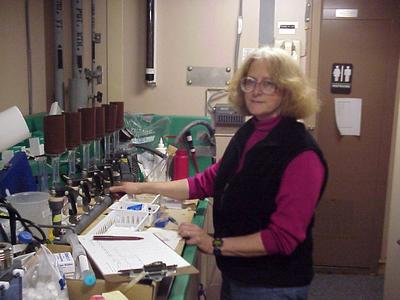
<> Ev Sherr is a professor of oceanography at Oregon State University in Corvallis, Oregon. On this cruise, she is looking at the grazing impact of protists (microzooplankton) on phytoplankton.

<> Jennifer Crain is one of a handful of scientists who are on both the SBI spring and summer cruises. She's working with Ev on the grazing impact of protists on phytoplankton.
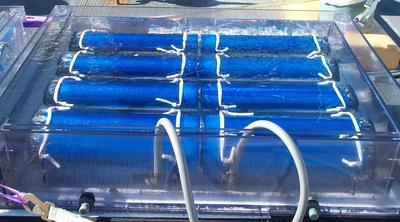
<> Ev and Jennifer incubate their samples for three days in two large incubator tanks on the bow of the ship.
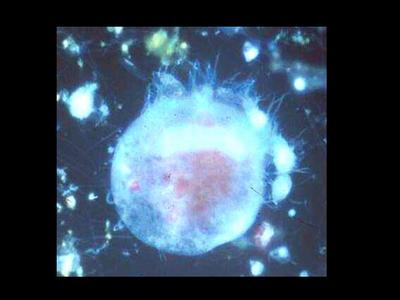
<> This is a ciliate (a type of protist) that you might find in the Arctic Ocean. The red color that you see inside is from the phytoplankton it has eaten. The picture is taken through a microscope. You can't see these organims with the naked eye.
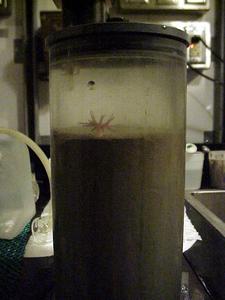
<> Jackie found this beautiful anemone in one of her respiration experiments. Although it is like the anemones you see in pictures of tropical coral reefs, this one lives 500 meters down in the cold Arctic Ocean.
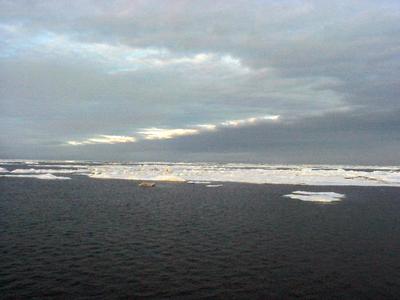
<> Around midnight, the sun finally reappeared for the first time in several days.
Contact the TEA in the field at
.
If you cannot connect through your browser, copy the
TEA's e-mail address in the "To:" line of
your favorite e-mail package.
|
